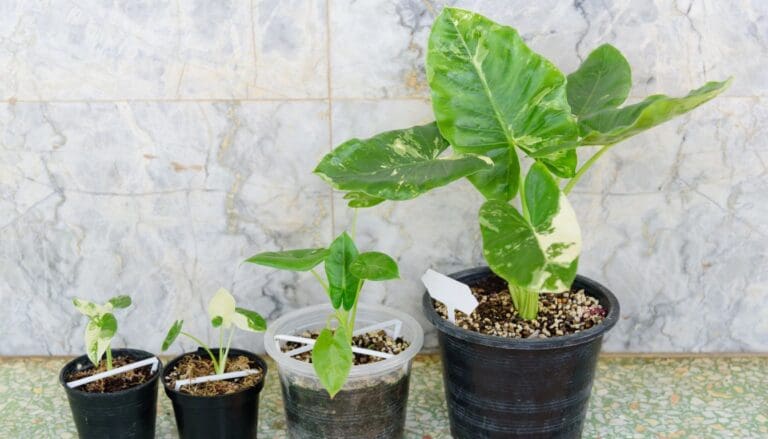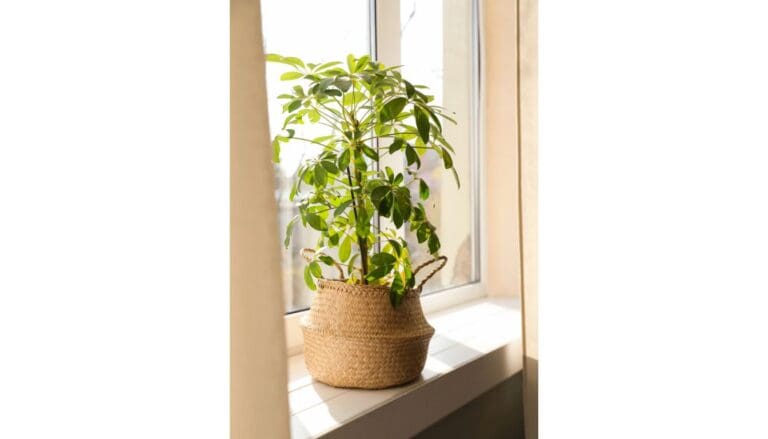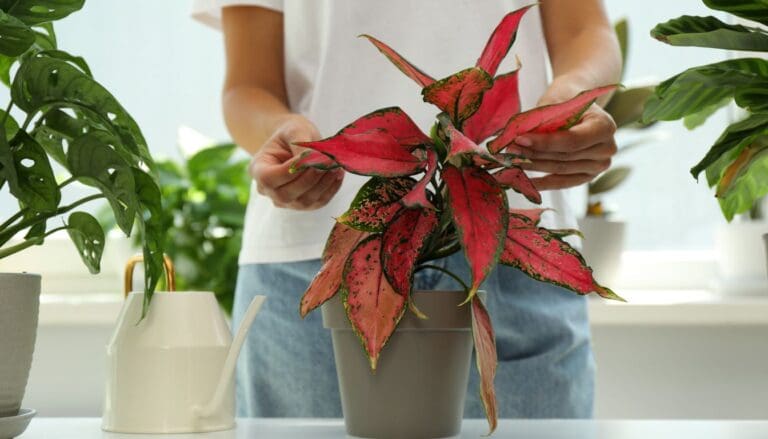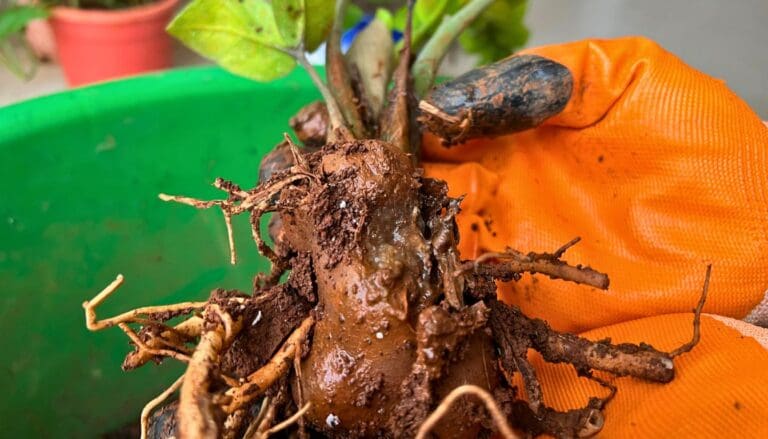How To Revive A Schefflera Plant? (8 Common Problems+Fix)
Schefflera, also known as umbrella plants, are tolerant and hardy plants grown indoors due to their low maintenance nature. However, the plant is not immune to problems and can show signs of stress.
If you see your Schefflera dying, you must take action to revive it.
- Inspect the plant and identify the exact issue.
- If you suspect root rot, take the plant out, inspect the roots, remove the decaying ones and repot in fresh potting mix.
- If the plant looks dehydrated, aerate the soil by poking holes. And then add water.
- If your umbrella plant was exposed to cold, place it in a warm spot and let it recover.
- If pests are the issue, spray Neem oil all over the plant for a few days.
- Ensure the plant gets enough light, sufficient humidity, and correct temperatures and does not face any challenges.
In this article, I will explain the details of the various causes that can kill the Schefflera and what measures should be taken to revive the plant.

Please note: Simplify Plants is reader-supported. Some links in the post are affiliate links and I get a commission from purchases made through links in the post.
Why is my Schefflera dying?
Schefflera is a hardy plant that will not suddenly die one day.
Unless the plant is undergoing some serious stress, it will not die.
The plant is strong enough to bounce back from issues if they are temporary, but if the conditions last for a long time, it might get difficult to revive the plant.
To revive the plant and help it bounce back, you must identify the root cause of the problem.
To identify the issue, you must examine the plant’s signs.
What are the signs of a dying Schefflera?
When the Schefflera faces a difficult situation, it will show certain signs to signify the unsuitable conditions.
You need to pick up those signs in the initial stages.
Some of the common signs that your Schefflera is undergoing a serious problem are:
- Yellowing or browning of leaves
- A droopy and wilted plant
- Curling of the leaves
- Crispy and dry foliage
- A foul smell coming from the soil
- Stunted growth
- Leaves falling off
How to revive a Schefflera plant?
If you notice your Schefflera is dying, the first step to reviving it is identifying the problem.
Most problems that disturb the plant are external conditions, which you can correct if it is not too late.
Let us now learn about the various problems that, if not checked, can kill your Schefflera.
Schefflera dying due to overwatering and root rot

Overwatering and root rot are the most common concern among all the reasons that can kill your Schefflera plant.
Not only beginners but experienced growers also mistake overwatering the plant.
This is because, being a tropical plant, Schefflera likes moist soil and does not prefer being bone dry, so plant parents tend to overwater them, thinking that the plant will like the wet soil.
It is understood that wet and soggy soil caused by overwatering is unsuitable for this plant.
Another reason for this mistake is following the same watering schedule all year.
It is very important to understand that you must change the watering pattern in winters from what you follow in summers.
In summers, due to intense heat, the evaporation rates are high, so the plant needs more water, but in winters, due to less light and heat, the plant needs very less water.
Overwatering the plant for an extended period leads to root rot.
This disease occurs when roots stay in water for too long.
It cuts out the oxygen supply and airflow, creating a perfect condition for rot, causing pathogens to attack the roots.
How to revive an overwatered Schefflera?
Overwatering, if identified in the early stages, can be treated.
Follow the below steps if you have been overwatering your umbrella plant.
- Cut down the watering immediately.
- Shift the plant to a brighter spot where there is enough airflow. This will help to dry out the soil faster.
- Empty the cache tray if you find it waterlogged.
- Prune the yellow or brown leaves off.
- Add a layer of mulch to the soil surface because it helps absorb the excess moisture.
- Don’t water again until you see the top 2-3 inches of the soil is dry.
- Use a moisture meter or do the finger test to check whether the plant needs water.
Overwatering can lead to root rot, which is tricky to handle.
Saving the plant can be difficult unless you treat the root rot in the initial stage.
Let us see the steps to revive the umbrella plant from root rot:
- Take the Schefflera out from the pot to check the condition of the roots.
- Remove all the extra soil from the roots by washing the roots under running water.
- Examine the roots well. Trim the rotten mushy leaves with a sterilized pruner.
- Apply some fungicide to the roots, which would help prevent further spreading of the rotting.
- Make a fresh potting mix that is light and well-draining.
- In a new pot with a drainage hole, pour this fresh soil and place the trimmed plant in the middle.
- Keep this repotted plant at a spot with good airflow and bright light.
- Do not disturb the plant and give it time to adjust to the new condition.
- Do not water until the top soil gets dry again.
- Never let the pot sit in a cache of water. Empty it regularly.
Also read: Root Rot In Schefflera: Signs, Causes & How To Fix
Schefflera dying due to underwatering

Underwatering stresses the plant just like overwatering because it cannot get the required amount of moisture from the soil to thrive.
Tropical plants constantly need moist soil and cannot tolerate bone dry soil for too long.
The plant begins to look dehydrated, weak, and crispy.
Though under watering can be treated quickly and is less severe than overwatering and root rot, you should not keep your plant dehydrated for too long.
How to revive an underwatered Schefflera?
If you have underwatered your Schefflera for some time, here is what you should do to revive the dehydrated plant:
- Poke the soil with a stick or a chopstick to help aerate the soil, which has become tight and compact.
- Take a large container and fill it with water. Then dip the Schefflera pot into this water and let it soak up for some time.
- Or you can water the soil and wait for some time until the plant absorbs all of it.
- Once all the water is absorbed, pour more water thoroughly until it runs off the drainage holes.
- Prune all the crispy yellow leaves as they will not turn green again but do not trim the droopy ones as they will bounce back once it is hydrated.
Here are some tips for you to prevent underwatering your plants:
- Use a calendar or an alarm clock to remind you to water your plant if you tend to forget to water.
- Water the plant whenever you feel the top 2 inches of the soil have become dry.
- You can use self-watering pots if you are too busy.
- Whenever you water the Schefflera, make sure you water until it runs off the drainage hole.
- Use a potting mix that can hold the required moisture.
- Change the watering schedule as per the season.
Also read: How Much Water Does A Schefflera Plant Need? (Watering Guide)
Schefflera dying due to low temperatures
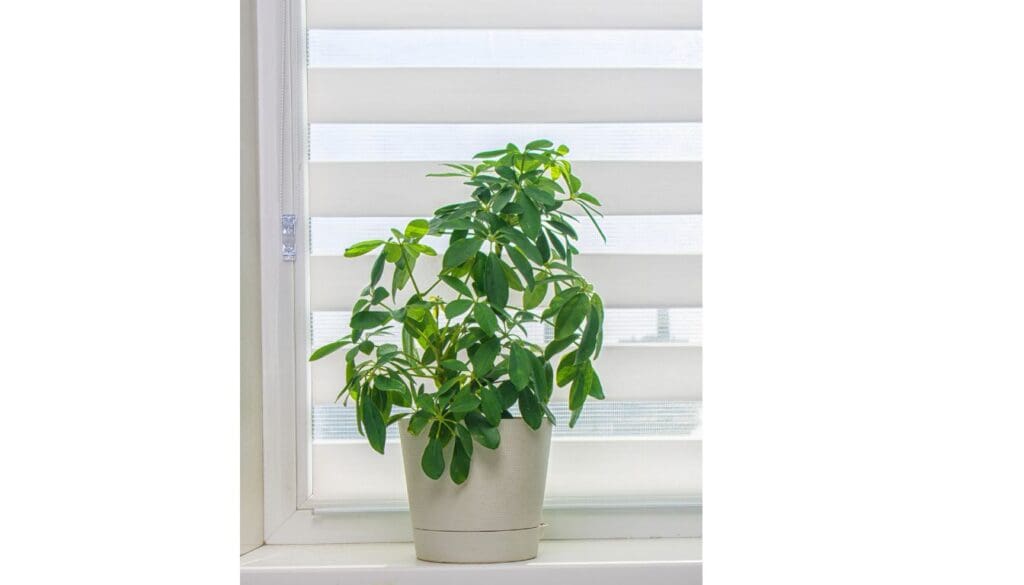
Schefflera being a tropical plant loves warm and humid conditions.
It is intolerant to extreme cold and frost.
If you live in areas with harsh winters, you would need to take special care of your umbrella plant.
If a frost or harsh cold sticks to your plant, it will experience cold injury, after which you must take steps to revive it or die.
It is advisable to bring your plant indoors right before the first frost to shield it from any mishap.
How to revive a cold-damaged Schefflera?
If you accidentally left your Schefflera plant outside during harsh cold and it experienced a cold injury, here are the steps you must follow to bring it back to health.
- Bring your Schefflera indoors immediately.
- Remove all the damaged, discolored parts of the plant as they cannot go green again.
- Shift it to a spot indoors where there is plenty of bright light and a few hours of mild morning sunlight, which would help keep it warm
- Keep the plant a few feet away if there is a fireplace or heater in the room.
- Remember not to keep the plant near any cold draft, window, or any vent from where cold air can hit the plant.
- Add a layer of mulch on the soil surface with organic elements like bark, leaves, and twigs to keep the soil warm and prevent the cold air from reaching the roots.
- Keep a watch on the watering routine. In winters, the soil stays wet for longer due to less light, reducing water requirements.
- Do not fertilize your Schefflera during the winter season.
Also read: Schefflera Care In Winter: Light, Watering,& More
Schefflera dying due to low light

Schefflera plants need bright light to thrive as they are not adaptable in low light conditions.
Some of the symptoms that your Schefflera is not getting enough light are:
- Droopy leaves
- Wet soil
- Stunted growth
- Yellow or pale green leaves
- Pest attacks
- Leggy growth
How to revive a Schefflera that is dying due to low light?
To revive a Schefflera that is not getting enough light, you should:
- Move the plant to a spot that receives bright indirect light.
- Prune the discolored leaves of the plant.
- Prune the leggy growth
- If your region does not have enough natural light, then install artificial lights.
Also read: What Kind Of Light Does A Schefflera Need?
Schefflera dying due to intense heat

In nature, Schefflera plants grow under the shade of bigger trees and are not equipped to tolerate direct sun rays.
The scorching sunlight can burn the leaves of this plant, leading to yellow and brown crispy dehydrated leaves.
How to revive a Schefflera that is dying due to too much heat?
- If your Schefflera has faced sunburn, you must protect it from direct sunlight.
- If the umbrella plant is outdoors, keep it under the shade of a bigger tree, against a wall, or on a patio where there is shade.
- If the plant is kept near a window, move it 5-6 feet away from the window so that direct sunlight does not reach it.
- Prune off the yellow and damaged leaves.
Also read: Schefflera Plant Temperature Tolerance: Ideal Temperature+Problems
Schefflera dying due to low humidity
Humidity is one of the most important requirements of umbrella plants.
They cannot withstand dry air and require at least 50%-60% humidity in the air.
If the plant does not get the required humidity, it shows signs like discolored leaves, wilting, dry-looking foliage, etc.
Unfortunately, the amount of humidity these plants enjoy is not naturally available in most homes, leading to stress in many Schefflera plants.
However, if your plant is sick due to low humidity, there are ways to revive it.
How to revive a Schefflera that experiences low humidity?
To revive an umbrella plant that experiences low humidity, you must increase the humidity around the plant.
There are multiple ways to do that.
- Humidifier: A humidifier is a small device that needs to be filled with water and kept near the plant. They give the most long-lasting effect, and you can also increase or decrease the humidity level around the plants with the help of this.
- Pebble trays: Another way to increase the humidity around your plants is by using pebble trays. You have to fill a large tray with water and pebbles. Then, carefully place the Schefflera on the pebbles, so the water does not touch the bottom of the pot. The water that evaporates from the tray helps to increase the humidity around the plant.
- Grouping: Grouping the tropical houseplants is another way to increase the humidity. Like in their native areas, grouping helps to create a humid atmosphere. However, before grouping, ensure none of the plants have any pest or fungal infestation.
- Misting: A simple and easy way to increase humidity is by misting the plant. However, its effects are very short-lived as the water evaporates quickly. So in summers, only misting might not be enough to give the plant humidity.
- Relocation: Relocating the umbrella plant to a spot in the house that is more humid is effective. Generally, in our homes, the kitchen, bathroom, and laundry rooms are some areas with more humidity.
Also read: Should I Mist My Schefflera? (+Humidity Requirement Guide)
Schefflera dying due to repotting shock

Repotting the plant into a new pot gives a lot of stress and shock to the plant, which is why it is recommended not to repot your plant too often.
Always repot only when the plant gets root-bound or if there is root rot.
Repotting at the wrong time and being too harsh with the plant can result in the death of the plant.
Repotting should be done only in spring and summer and never in winters as the plant stays dormant and it gets more difficult to overcome the shock.
How to revive a Schefflera that is undergoing repotting shock?
Schefflera are quite hardy and can bounce back after overcoming the repotting stress.
You can follow a few ways to help the plant recover easily from the shock.
- After repotting, keep the plant at a spot with mild and moderate temperatures.
- Do not put the plant under direct sunlight.
- Do not fertilize the plant after repotting it as that can burn the sensitive roots.
- Do not repot in fall and winter.
- Always repot only in the growing season, which is spring and summer.
Also read: How To Repot A Schefflera Plant? (A Step-by-Step Guide)
Schefflera dying due to pest infestation

Pests can be highly damaging to any plant, and Schefflera is no different.
These pets attach themselves to the plants and suck out the sap containing essential nutrients, leaving them weak and droopy, and if left untreated, they can kill them.
Many pests attack the Schefflera like mealybugs, spider mites, scales, aphids, and thrips.
They must be treated at the initial stage to revive your plant.
If you notice any pest infestation on your plant, you mustn’t ignore it and treat it as soon as possible.
How to revive a Schefflera dying due to pests?
To revive a Schefflera that pests have attacked, you should do the following:
- First, you need to isolate the plant, so the pests do not spread to other plants.
- Next, wash the plant under running water to clear the pests.
- Prune off the parts that still have pests attached to them.
- Then spray Neem oil generously over the plant. Neem oil is an organic pesticide that removes all sorts of bugs from plants.
- You can also dip cotton in rubbing alcohol and rub it over the infested areas.
- If the infestation is too severe, you can use pesticides but read the instructions carefully before use.
To prevent pest infestations in the future, remember the following:
- Keep the plant in a spot that is well ventilated. Good airflow and bright lights keep pests away.
- Do not crowd the plants too close to each other. It restricts the flow of air around the plants.
- Spray the plants with Neem oil periodically to give the leaves clean and free from pests.
- Do not keep the leaves wet for long as wet leaves attract fungus and pests.
Also read: Schefflera Pest Problems: Common Pests & Diseases+How To Fix
Final words
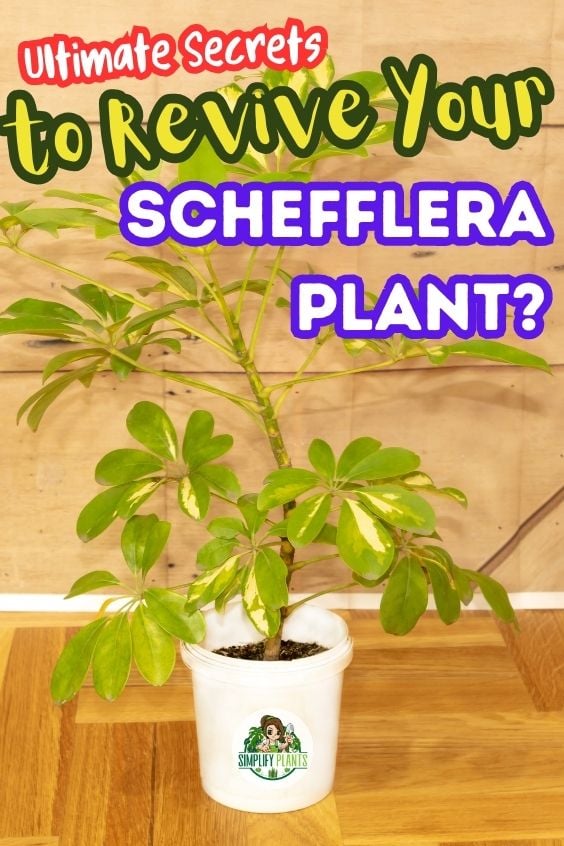
If your Schefflera is dying, do not panic. You can save it if you identify the exact problem on time. I have mentioned all the possible reasons and their remedies in this article which will help you revive your Schefflera.
However, if it is too late to save the plant, consider propagating one or more healthy branches and discard the rest. Don’t be disheartened, as understanding houseplants take time and practice.
In most cases, your umbrella plant will bounce back with the right treatment at the right time, so keep an eye on the plant and treat it as soon as you notice any issue.
Reference: Wikipedia, Sciencedirect, Britannica, American Society for Horticultural Science, Schefflera taxonomic history.
Recommended Garden Supplies
| Product Image | Our Recommended Gardening Supplies | Check Offers! |
|---|---|---|
Top Top
Top
Top
Top
Top
Top
Top
Top | rePotme Houseplant and Tropical Classic Potting Soil Mix | Check Offer On Amazon |
 Top
Top
Top
Top
Top
Top
Top
Top | Espoma Organic Indoor Plant Food | Check Offer On Amazon |
 Top
Top
Top
Top
Top
Top
Top
Top | GooingTop LED Grow Light 6000K Full Spectrum Clip Plant Growing Lamp | Check Offer On Amazon |
 Top
Top
Top
Top
Top
Top
Top
Top | Soil Moisture Meter | Check Offer On Amazon |
 Top
Top
Top
Top
Top
Top
Top
Top | Govee Hygrometer Thermometer, Bluetooth Enabled! | Check Offer On Amazon |
 Top
Top | LEVOIT Humidifiers for Large Room(Best For Plants) | Check Offer On Amazon |
 Top
Top
Top
Top
Top
Top
Top
Top | Upgraded DIY Automatic Drip Irrigation Kit, 15 Potted Houseplants Support | Check Offer On Amazon |
 Top
Top
Top
Top
Top
Top
Top
Top | Stainless Steel Heavy Duty Gardening Tool Set | Check Offer On Amazon |
 Top
Top
Top
Top
Top
Top
Top
Top | Bonide Insecticidal Soap | Check Offer On Amazon |
 Top
Top
Top
Top
Top
Top
Top
Top | Bonide 32 oz Spray Neem Oil for Organic Gardening | Check Offer On Amazon |
 Top
Top
Top
Top
Top
Top
Top
Top | Garden Safe Fungicide | Check Offer On Amazon |

